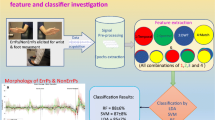Abstract
Brain-computer interfaces have been proposed for stroke rehabilitation, but there are some impeding factors for them to be translated into clinical practice. One of them is the need for calibration. In this study it was investigated if subject-independent calibration is possible for detecting movement-related potentials associated with hand movements, and what the optimal number of movement epochs is to maximize the detection performance. Twelve healthy subjects performed 100 palmar grasps while continuous EEG was recorded. Template matching was performed between movement and idle epochs. 72 ± 10% of all epochs were correctly classified using the subject-independent approach while 78 ± 9% of the epochs were correctly classified using the individualized approach. The highest classification accuracies were obtained when using 54 ± 23 movement epochs for calibration. In conclusion, it is possible to use a subject-independent approach for detecting movement-related cortical potentials, but the performance is slightly lower compared to individualized calibration.
Access this chapter
Tax calculation will be finalised at checkout
Purchases are for personal use only
Similar content being viewed by others
References
R. Xu et al., A closed-loop brain-computer interface triggering an active ankle-foot orthosis for inducing cortical neural plasticity. IEEE Trans. Biomed. Eng. 20(4), 2092–2101 (2014)
M.A. Cervera et al., Brain-computer interfaces for post-stroke motor rehabilitation: a meta-analysis. Ann. Clin. Transl. Neurol. 5(5), 651–663 (2018)
M. Jochumsen et al., Investigation of optimal afferent feedback modality for inducing neural plasticity with a self-paced brain-computer interface. Sensors 18(11), 3761 (2018)
N. Mrachacz-Kersting et al., Precise temporal association between cortical potentials evoked by motor imagination and afference induces cortical plasticity. J. Physiol. (Lond.) 590(7), 1669–1682 (2012)
M. Jochumsen et al., EMG-versus EEG-triggered electrical stimulation for inducing corticospinal plasticity. IEEE Trans. Neural Syst. Rehabil. Eng. 27(9), 1901–1908 (2019)
J. Ibáñez et al., Detection of the onset of upper-limb movements based on the combined analysis of changes in the sensorimotor rhythms and slow cortical potentials. J. Neural Eng. 11(5), 056009 (2014)
M. Jochumsen et al., Detecting and classifying movement-related cortical potentials associated with hand movements in healthy subjects and stroke patients from single-electrode, single-trial EEG. J. Neural Eng. 12(5), 056013 (2015)
M. Jochumsen et al., Evaluation of EEG headset mounting for brain-computer interface-based stroke rehabilitation by patients, therapists, and relatives. Frontiers Hum. Neurosci. 14 (2020)
S. Fazli et al., Subject independent EEG-based BCI decoding. Adv. Neural Inf. Process. Syst. 22, 513–521 (2009)
M. Krauledat et al., Towards zero training for brain-computer interfacing. PLoS ONE 3(8) (2008)
I.K. Niazi et al., Detection of movement-related cortical potentials based on subject-independent training. Med. Biol. Eng. Comput. 51(5), 507–512 (2013)
M. Jochumsen et al., Effect of subject training on a movement-related cortical potential-based brain-computer interface. Biomed. Signal Process. Control 41, 63–68 (2018)
Acknowledgements
This work was funded by VELUX FONDEN (project no. 22357).
Author information
Authors and Affiliations
Corresponding author
Editor information
Editors and Affiliations
Rights and permissions
Copyright information
© 2022 The Author(s), under exclusive license to Springer Nature Switzerland AG
About this paper
Cite this paper
Jochumsen, M. (2022). Subject-Independent Detection of Movement-Related Cortical Potentials and Classifier Adaptation from Single-Channel EEG. In: Torricelli, D., Akay, M., Pons, J.L. (eds) Converging Clinical and Engineering Research on Neurorehabilitation IV. ICNR 2020. Biosystems & Biorobotics, vol 28. Springer, Cham. https://doi.org/10.1007/978-3-030-70316-5_13
Download citation
DOI: https://doi.org/10.1007/978-3-030-70316-5_13
Published:
Publisher Name: Springer, Cham
Print ISBN: 978-3-030-70315-8
Online ISBN: 978-3-030-70316-5
eBook Packages: EngineeringEngineering (R0)




